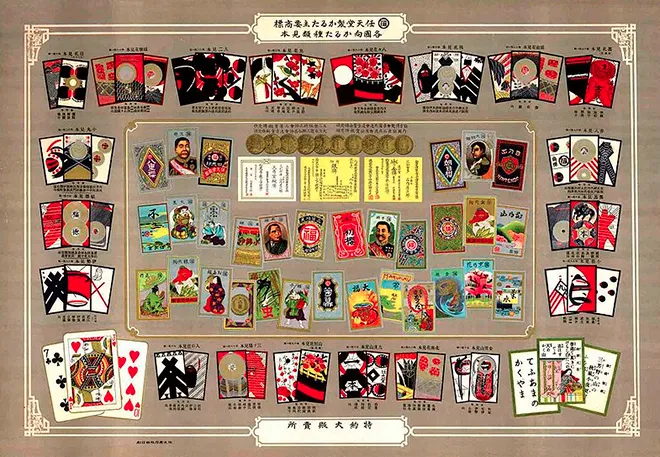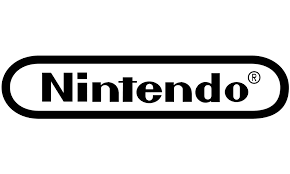Nintendo
Japanese playing cards to Game Boy and Super Mario
Nintendo is a Japanese gaming company that develops video games and devices. It was founded in 1889 by Fusajiro Yamauchi as a playing card company, and is now headquartered in Kyoto, Japan. Today it is still the leading playing-card maker in Japan, still producing Hanafuda decks. However the business has diversified into computer games ,devices and a multitude of characters.
In 1889, Fusajiro Yamauchi founded Nintendo Koppai in Kyoto, Japan, to manufacture hanafuda, a type of Japanese playing cards.
Western-style playing cards originally came to Japan in the 16th century with Portuguese traders, but over the ensuing three centuries a variety of different card games were created in Japan. The most popular in the late 1800s were hanafuda, cards printed with beautiful, colorful images of flowers. The yakuza often used hanafuda in their illicit gambling halls.

The fact that the cards were often used for gambling was reflected in the name Yamauchi gave to his company. “Nin-ten-do” is written with characters that mean, roughly, “luck-heaven-hall,” or the place where you put your fortune in the hands of the gods.
Over the next 60 years, Nintendo became the country’s preeminent maker of playing cards, expanding into making toranpu (“trump,” for Western playing cards) and introducing a number of innovations to the Japanese market. The firm was the first to produce durable plastic-coated playing cards in Japan, and struck a deal to print cards with Disney characters on the backs. This had the effect of widening the market for playing cards, turning a gambler’s tool into a children’s toy.
The Nintendo company stayed in the hands of the Yamauchi family for over a century. Fusajiro Yamauchi’s great-grandson Hiroshi took over in 1949 at the young age of 22.
One of the new president’s first acts was to have all remaining Yamauchi family members fired, so that it would be clear who was in charge. Yamauchi oversaw the expansion of the company out of the playing-card business and into a wide variety of other products, all of which were failures – until the company moved into electronic toys and games.
Forging a partnership with the hardware maker Sharp that has lasted to this day, Nintendo engineers developed unique electronic toys like the Beam Gun, which used solar cells to let kids imagine they were firing a gun and making targets explode. From there, the company expanded into home and arcade videogames.
Nintendo, to this day, is the predominant playing-card maker in Japan, still producing hanafuda decks, although some of them now have Super Mario characters printed on them instead of flowers.
1970s: Entering the Video Game Industry
Nintendo’s pivotal turn toward the gaming industry occurred in the early 1970s:
- 1972: Nintendo first delved into the arcade game market with EVR Race and later Computer Othello. While not hugely successful, it laid the groundwork for future ventures.
- 1977: The company released Color TV-Game, a series of home consoles (similar to Pong), which helped establish Nintendo’s presence in the video game space.
- 1978: Nintendo’s arcade division, under Gunpei Yokoi, introduced Game & Watch (1980), a line of handheld electronic games, which became a precursor to portable gaming.
- 1979: The game Donkey Kong marked a major breakthrough. Created by Shigeru Miyamoto, it introduced the world to Mario, one of Nintendo’s most iconic characters.
1980s: Rise of Iconic Characters and the Famicom Era
The 1980s were pivotal in shaping Nintendo’s legacy, and the company solidified its place as a gaming juggernaut:
- 1981: Donkey Kong (arcade) introduced Mario (originally named “Jumpman”) and established Nintendo as a major player in the arcade market. The success of Donkey Kong and its characters laid the groundwork for Super Mario Bros. in the following years.
- 1983: Nintendo released the Famicom (Family Computer) in Japan, a home console that would later be rebranded as the Nintendo Entertainment System (NES) for the global market. The NES revolutionized home gaming, introducing iconic franchises like Super Mario Bros., The Legend of Zelda, and Metroid.
- 1985: The release of Super Mario Bros. for the NES was a game-changer, solidifying Nintendo’s dominance in the video game market. The game’s gameplay mechanics and character design set new standards for platformers.
- 1989: Nintendo launched the Game Boy, the world’s first widely successful portable gaming system. Its Tetrisbundle proved to be a game-changer, turning handheld gaming into a global phenomenon.
1990s: 3D Gaming and Console Wars
The 1990s saw the gaming industry evolve into a competitive space with cutting-edge technologies, rivalries, and the birth of iconic franchises:
- 1991: The Super Nintendo Entertainment System (SNES) launched, further expanding Nintendo’s global influence. Classic titles like The Legend of Zelda: A Link to the Past, Super Mario World, and Super Metroidbecame staples of the era.
- 1996: The Nintendo 64 was released, marking Nintendo’s entry into 3D gaming. With Super Mario 64, The Legend of Zelda: Ocarina of Time, and GoldenEye 007, the N64 set the standard for 3D platformers and shooters. The console’s use of cartridges, however, limited third-party support compared to Sony’s PlayStation(which used CDs).
- 1998: Nintendo introduced the Game Boy Color, an enhanced version of the Game Boy, offering color graphics and a robust library of titles.
- 1999: Pokémon Red and Blue launched in North America, quickly becoming a cultural phenomenon and establishing the Pokémon brand, which would go on to be one of the most profitable and influential in gaming history.
Shigeru Miyamoto, Nintendo’s legendary game designer, created The Legend of Zelda based on his childhood adventures in Sonobe, Japan. Supposedly, As a young boy, Miyamoto loved wandering through forests, exploring caves, and discovering hidden ponds near his hometown. His sense of curiosity and wonder heavily influenced the gameplay, practically encouraging players to explore open worlds and uncover secrets. This is a perfect example of how real-life childhood experiences can inspire groundbreaking happenings in the virtual and actual worlds.
2000s: Innovation, the Rise of Handhelds, and Online Gaming
The 2000s saw continued innovation and expansion into new areas:
- 2001: Nintendo GameCube was released, though it struggled against Sony’s PlayStation 2 and Microsoft’s Xbox. Nevertheless, the GameCube was home to beloved titles like Super Smash Bros. Melee, The Legend of Zelda: The Wind Waker, and Metroid Prime.
- 2004: Nintendo DS hit the market and became the best-selling handheld console of all time. Its dual-screen design, with a touch screen on the bottom, was revolutionary, and games like Mario Kart DS, Nintendogs, and Brain Agehelped it become a massive success.
- 2006: Wii launched and became a global phenomenon, thanks to its unique motion-sensing controller. The Wii’s innovative gameplay experience, exemplified in games like Wii Sports and Super Mario Galaxy, attracted a broad audience, including casual gamers. The Wii’s success also marked the beginning of Nintendo’s shift towards a more family-friendly, accessible gaming philosophy.
- 2007: The Legend of Zelda: Twilight Princess became a critical and commercial success, continuing the series’ legacy as one of the most beloved franchises in gaming.
- 2008: Nintendo’s DS and Wii helped to reshape gaming’s target audience, moving beyond traditional gamers to include families, seniors, and non-gamers.
Shigeru Miyamoto says that Mario’s appearance went through some drastic changes because of the technological boundaries of the day. The hat was used to cover the hair which could not be shown because it would be bland and non-believable. They used white gloves to help the player track his movements and a mustache was added to add at least a facial feature to the character.
All of those features now shape his iconic characteristics which have been used throughout all these years. From different video games to cameos and movies, Mario is everywhere and has brought joy to billions of people.
2010s: The Rise of the Switch and New Business Models
The 2010s marked a decade of bold risks and successful reinventions:
- 2011: The Nintendo 3DS debuted with glasses-free 3D technology, offering experiences like Super Mario 3D Land and The Legend of Zelda: A Link Between Worlds. It became a major success despite a rocky start, thanks to a price drop and strong software lineup.
- 2012: Wii U, a follow-up to the Wii, struggled commercially despite its innovative GamePad controller with a touchscreen. However, it was home to standout games like Super Mario 3D World, Splatoon, and The Legend of Zelda: Breath of the Wild (which was later released on the Nintendo Switch).
- 2017: Nintendo Switch launched, combining the best of home console and handheld gaming into one device. Its hybrid design, ability to play on the go, and accessibility to a wide range of gamers made it a runaway success. Iconic games like The Legend of Zelda: Breath of the Wild, Super Mario Odyssey, and Animal Crossing: New Horizons helped make the Switch one of the best-selling consoles of all time.
2020s: Expanding Influence and Continued Innovation
In the 2020s, Nintendo remains a dominant player in the gaming world, focusing on unique experiences and expanding its impact beyond gaming:
- 2020: Animal Crossing: New Horizons became a massive success, particularly during the COVID-19 pandemic, as it provided a much-needed escape for millions of players worldwide.
- 2023: Super Mario Bros. Movie, a collaboration with Illumination Entertainment, was released, showcasing Nintendo’s broader ambitions in entertainment beyond games, further cementing Mario’s status as a global pop culture icon.
- 2024 and beyond: Nintendo continues to innovate with its hardware, gaming experiences, and expansions into various forms of media, while also preserving its rich legacy of beloved franchises like Super Mario, Zelda, Pokémon, and Metroid.
Nintendo has changed its name various times throughout the company’s history. Back in 1963, the company’s third president (Hiroshi Yamauchi) renamed it from Nintendo Playing Card Co. Ltd. To Nintendo Co. Ltd because they had changed their main business models and approach. But as it is a Japanese company, the name gets its root from Kanji characters. Nin, Ten and Do translate to “leave luck to heaven” which sounds as poetic as it is strange.
Some of Nintendo’s key innovation milestones over the last 5 decades have included:
- Handheld Gaming: With the Game Boy in 1989 and subsequent consoles like the DS, Nintendo helped popularize portable gaming, ensuring it would be a permanent part of the gaming landscape.
- Motion Controls: The Wii’s motion-sensing controllers revolutionized gaming by introducing motion-based interaction, making gaming more active and accessible.
- Hybrid Console Design: The Nintendo Switch’s hybrid concept (play at home or on the go) redefined the console market and proved to be a massive commercial success.
- Innovative Game Design: Nintendo’s games consistently push the envelope with creativity, character design, and world-building, from Super Mario to Zelda and beyond.
- Family-Friendly Appeal: Nintendo’s consoles and games have consistently attracted a wide demographic, from young children to older adults, fostering a diverse and inclusive gaming community.
